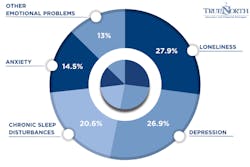The miles are long and lonely. The distance from family and home is often great, and the pay and benefits often don’t compensate. Professional long-haulers do their jobs and get their loads where they need to be remarkably efficiently under such circumstances, but they can turn to distractions—mobile electronics and online shopping addictions, fast food, drugs and alcohol, sex-for-hire—out of some combination of boredom and disconnectedness. Experts are shining a light on why.
What aggravated this solitary state for drivers? COVID-19, many say. And the pandemic placed an all-new focus on driver mental wellness and on interventions that can help them, noted Mark Murrell, a leading trucking industry stakeholder and co-founder of CarriersEdge, the provider of online truck driver training. Mental health happens to be the focus of the most recent addition, released in February, to the CarriersEdge library of offerings, Murrell reminded FleetOwner in a recent interview.
See also: How to approach mental health in trucking
“General driver health and wellness has been an issue for a long time, and we’ve had education content as part of our library for years,” Murrell said. “Recognizing and preventing fatigue, how to get exercise on the road, eating better, how to get better sleep. Those work together.”
Of the most recent CarriersEdge addition, a course about mental health, Murrell said driver psychological wellness is “a real hot issue coming out of the COVID-19 pandemic. There were a lot of stresses on the road. Isolation was always a top concern, but when you add more—you can’t get into restrooms, etc., all the in-person things you couldn’t do or access—it gets that much worse.”
Speaking of learning, Murrell said CarriersEdge has learned much about general driver health and wellness—and the trends in trucker mental health especially—from its work on the Best Fleets to Drive For, an annual evaluation and awards for the best workplaces in North American trucking, the carriers that take great care to look after employee health and wellness, especially their drivers. Each year, based on nominations accepted every September and October, the Best Fleets program names an overall large carrier and small carrier Best Fleet, a top 20 fleets list, inducts multiyear winners into a hall of fame, and names carriers to watch.
See also: Inside the journey of trucking's grand champion
CarriersEdge, Murrell said, wanted to be “part of getting the message out that a driver shouldn’t just have to deal with such things.” He added that fleets have started to have more mental health-specific support, such as making chaplains and support groups available to drivers. “We recognized that [mental health] was a real concern for drivers.” The seriousness of the mental health crisis among drivers doesn’t come into any sharper view than when suicide strikes, he said. “We know somebody who was involved in a suicide by truck,” Murrell told FleetOwner. “Those things happen more than we talk about.”
Even prior to the pandemic, transportation workers exhibited the fourth-highest suicide rate for both males and females among occupational groups, according to data from the U.S. Centers for Disease Control and Prevention. Truck drivers are fifth on the list of highest risk for work-related suicide, according to the American Foundation for Suicide Prevention.
If you are a professional driver or any trucking industry employee thinking about suicide, seek help by dialing 988 on any cellphone or landline to reach the Suicide & Crisis Lifeline, which is available 24/7 and is free and confidential. The hotline also offers help to non-English speakers.
Another resource for truckers and their families is the National Association of Mental Illness, which offers a free crisis helpline and other mental health resources throughout the United States. Reach the helpline by phone at 800-950-6264 or text 62640.
Suicide prevention in focus this month
September is National Suicide Prevention Month, when mental health advocates, prevention organizations, survivors and their allies, and community members unite to promote suicide prevention with National Suicide Prevention Week the week after Labor Day and World Suicide Prevention Day recognized as Sept. 10.
To coincide with these observances, provider-centric mental health group Grow Therapy released results of a recent survey of providers on the warning signs and trends that therapists see. Trucking companies like Sara Graf’s Estes Express Lines provide talk therapy to employees, including Estes’ 10,200 drivers, through their benefits and employee assistance programs, said Graf, who noted the programs vital importance to Estes Express employees.
See also: The health risks of driver isolation and loneliness
The Grow Therapy findings "reveal that providers are actively engaged in identifying and understanding suicide risk with their clients, but they recognize that there continue to be misconceptions, barriers, and cultural factors that impact suicide prevention efforts,” said Cynthia Grant, head of clinical at Grow Therapy. “Our goal of this survey is to provide a more comprehensive understanding of the fundamental elements that may influence suicidal thinking and behaviors.”
A few key findings of the Grow Therapy report were:
- Warning signs: The most common warning sign of suicide risk that therapists in the survey reported seeing among clients is feelings of hopelessness or worthlessness (61%). This is followed by increased social withdrawal and isolation (23%), sudden improvement in mood after a period of depression (11%), and giving away prized possessions or making final arrangements (5%).
- Misconceptions: Therapists reported that the most common misconception surrounding suicide is that talking about suicide will plant the idea in someone's mind (60%). This was followed by believing that only people with a diagnosed mental illness are at risk of suicide (19%), that once someone experiences suicidal ideation, they will struggle with it for the rest of their life (16%), and that suicide is always an impulsive act (5%).
- Barriers: Therapists reported that the biggest barrier to seeking therapy for suicidal ideation is the stigma and fear of judgment from others (58%). Other common barriers are having a prior negative experience when seeking help (49%), reluctance to discuss personal struggles openly (26%), limited access to affordable mental health services (21%), and a lack of awareness about available resources (9%).
- Cultural and demographic factors: 75% of providers reported that cultural beliefs and attitudes toward mental health create barriers for individuals like isolated and lonely truck drivers who are at risk of suicide, as opposed to only 4% reporting language barriers, which shows that there is still work to be done in society regarding the stigma of mental health. Other cultural or demographic factors that create barriers include socioeconomic disparities resulting in limited access to mental health services (47%), accessibility of culturally competent therapists (18%), and intersectionality and the experiences of marginalized groups (18%).
- Prevention strategies: Therapists reported that the most effective safety planning strategy is helping clients identify reasons for living (19%). They also say this can be the most challenging strategy for clients (25%). Other effective strategies noted were reducing access to lethal means (16%) such as access to weapons or drugs, identification of warning signs (16%), coping strategies (14%), social supports (14%), and contacts during a crisis (5%).
- Treatment: 25% of therapists reported that medication paired with talk therapy is the most effective method of addressing suicidal thoughts.
This is the first part of a feature on driver health and wellness that appeared in FleetOwner magazine. Part 2 is also on FleetOwner.com.
About the Author
Scott Achelpohl
Managing Editor
Scott Achelpohl is a former FleetOwner managing editor who wrote for the publication from 2021 to 2023. Since 2023, he has served as managing editor of Endeavor Business Media's Smart Industry, a FleetOwner affiliate.


